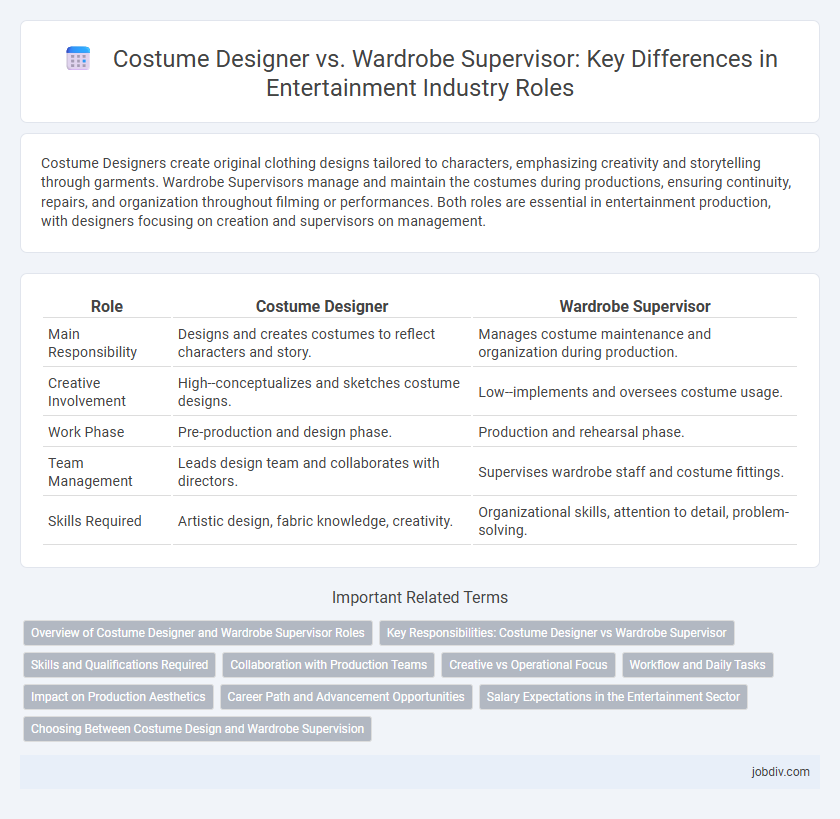Costume Designers create original clothing designs tailored to characters, emphasizing creativity and storytelling through garments. Wardrobe Supervisors manage and maintain the costumes during productions, ensuring continuity, repairs, and organization throughout filming or performances. Both roles are essential in entertainment production, with designers focusing on creation and supervisors on management.
Table of Comparison
| Role | Costume Designer | Wardrobe Supervisor |
|---|---|---|
| Main Responsibility | Designs and creates costumes to reflect characters and story. | Manages costume maintenance and organization during production. |
| Creative Involvement | High--conceptualizes and sketches costume designs. | Low--implements and oversees costume usage. |
| Work Phase | Pre-production and design phase. | Production and rehearsal phase. |
| Team Management | Leads design team and collaborates with directors. | Supervises wardrobe staff and costume fittings. |
| Skills Required | Artistic design, fabric knowledge, creativity. | Organizational skills, attention to detail, problem-solving. |
Overview of Costume Designer and Wardrobe Supervisor Roles
Costume Designers create the overall vision and design of characters' clothing, collaborating closely with directors to establish visual storytelling through fabric, color, and style. Wardrobe Supervisors manage the maintenance, organization, and continuity of costumes during production, ensuring all garments are ready for daily shoots and quick changes. Together, these roles combine creative design with practical execution to bring characters' appearances to life on screen or stage.
Key Responsibilities: Costume Designer vs Wardrobe Supervisor
Costume designers create the overall visual concept by researching, sketching, and selecting fabrics to develop characters' looks that align with the production's theme and director's vision. Wardrobe supervisors manage the day-to-day care, organization, and maintenance of costumes during rehearsals and performances, ensuring quick changes and repairs are executed efficiently. Their key responsibilities differ as designers drive creative direction while supervisors focus on practical execution and costume continuity.
Skills and Qualifications Required
Costume designers require strong artistic skills, a deep understanding of fabric, color theory, and historical fashion, along with a background in fashion design or theater arts. Wardrobe supervisors need excellent organizational abilities, leadership experience, and proficiency in garment maintenance, fitting, and continuity management. Both roles benefit from knowledge of costume construction, but designers prioritize creativity while supervisors emphasize operational and team management skills.
Collaboration with Production Teams
Costume designers and wardrobe supervisors collaborate closely with production teams to ensure visual consistency and character authenticity in film and theater. Costume designers create detailed designs reflecting the director's vision, while wardrobe supervisors manage the practical aspects of costume maintenance and daily outfit coordination during shoots or performances. This partnership streamlines wardrobe logistics, enhances storytelling through apparel, and supports seamless production workflows.
Creative vs Operational Focus
Costume designers concentrate on the creative development of characters through clothing, using artistic vision to craft unique, period-accurate, and emotionally resonant costumes that enhance storytelling. Wardrobe supervisors manage the operational aspects, ensuring costumes are maintained, organized, and readily available during production, coordinating fittings, repairs, and continuity on set. The interplay between the costume designer's creative direction and the wardrobe supervisor's logistical execution is crucial for a seamless visual narrative in film, theater, and television.
Workflow and Daily Tasks
Costume designers develop detailed character wardrobes by researching, sketching, and selecting fabrics to create original costume concepts aligned with a production's vision. Wardrobe supervisors manage the organization, maintenance, and quick repairs of costumes during rehearsals and performances, ensuring seamless outfit changes and proper fit. The workflow of costume designers focuses on pre-production planning and collaboration with directors, while wardrobe supervisors oversee on-set costume continuity and adaptability under tight schedules.
Impact on Production Aesthetics
Costume designers shape the visual identity of a production by creating outfits that reflect character personalities, time periods, and narrative themes, directly influencing the overall aesthetic cohesion. Wardrobe supervisors ensure the integrity and consistency of these designs during filming or performances, managing costume maintenance and quick changes to maintain visual continuity. Their combined efforts result in a seamless representation of character and story, enhancing the production's immersive quality and audience engagement.
Career Path and Advancement Opportunities
Costume designers typically begin their careers with formal education in fashion or theater design, progressing through internships and assistant roles before leading design projects for films, theater, or television, with advancement often leading to head designer or creative director positions. Wardrobe supervisors often enter the industry through hands-on experience or as wardrobe assistants, managing costume logistics and maintenance, and can advance to production costume coordinator or head wardrobe supervisor roles with increased responsibility on larger productions. Both paths offer opportunities for growth within the entertainment industry, but costume designers usually focus on creative leadership, while wardrobe supervisors emphasize operational management.
Salary Expectations in the Entertainment Sector
Costume Designers in the entertainment sector typically earn between $60,000 and $100,000 annually, reflecting their creative input and leadership in visual storytelling. Wardrobe Supervisors usually receive a salary ranging from $40,000 to $65,000, as their role centers on managing costume logistics and maintenance. Salary variations depend on the production scale, geographic location, and individual experience within the industry.
Choosing Between Costume Design and Wardrobe Supervision
Choosing between costume design and wardrobe supervision hinges on creative vision versus logistical expertise within entertainment production. Costume designers craft original clothing concepts that define characters and eras, requiring strong skills in fashion history, sketching, and fabric selection to enhance storytelling. Wardrobe supervisors focus on organizing, maintaining, and fitting costumes during production, ensuring continuity and timely costume changes, demanding exceptional attention to detail and efficient management capabilities.
Costume Designer vs Wardrobe Supervisor Infographic

 jobdiv.com
jobdiv.com